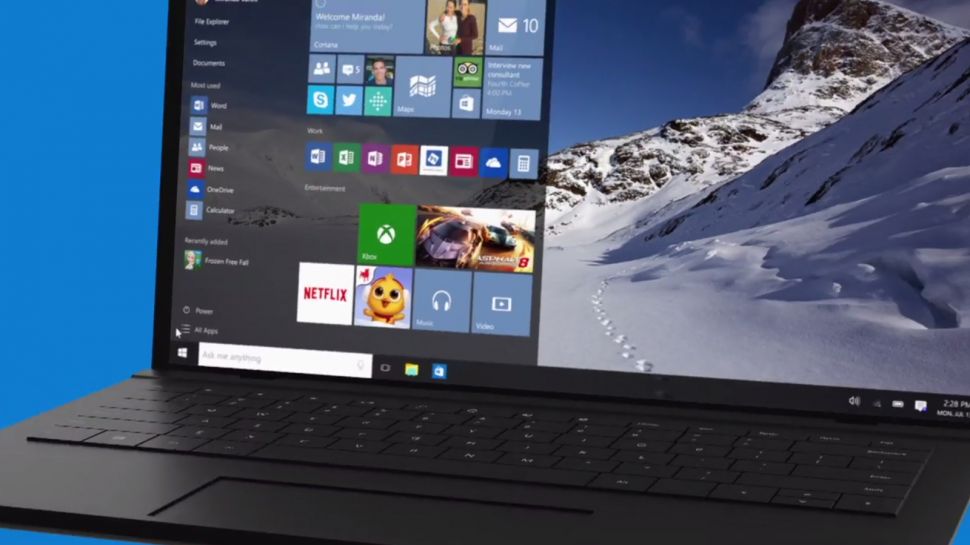Windows 10 will be launching in T-minus seven days and will be offered for free within its first year of availability to Windows 7 and 8 users. Not only will the beloved Start button be back in Windows 10, but Windows 10 will also include a personal assistant, Cortana. What’s more, the new operating system will introduce many promising security features and a new browser.

Image: TechRadar
Hello there, Windows Hello and Passport!
Windows Hello is biometric authentication that either scans your face, iris or fingerprint to access your Windows 10 device – very secret agent-like security! By doing so, Windows Hello eliminates the chance of hackers stealing your password to access your device, simply because you will no longer have a password to begin with!
Windows Passport also eliminates the use of passwords to access your online accounts. For now, Microsoft will work with the Azure Active Directory and has joined the FIDO alliance to subsequently support password replacement for other consumer, financial and security services. Windows will verify that you are truly the one using your device through a PIN or via Windows Hello, and then it will authenticate Windows Passport so you can log in to websites and services without ever using a password. Combined use of Windows Hello and Windows Passport would mean that a hacker would not only have to physically steal your device, but also kidnap you to access your accounts.
You will, of course, need hardware that is capable of infrared scanning your face or iris, or that has a built-in fingerprint reader to use Windows Hello. Microsoft has already confirmed that all OEM systems with Intel® RealSense™ 3D Camera (F200) will support Windows Hello’s facial unlock features.
Bye-bye Patch Tuesday
Microsoft usually issues security patches on the second Tuesday of every month, which can leave users vulnerable until Patch Tuesday comes around. In Windows 10, Microsoft will regularly issue security patches and users will be forced to accept every update, meaning they will be immediately protected from zero-day bugs.
Forcing updates is a good move. It’s the same as with an antivirus – everyone wants to have an up-to-date database to protect their system as much as possible. – Jiri Sejtko, Director of Virus Lab Operations
More app developer security support
AMSI – Antimalware Scan Interface will help protect users from script-based malware by offering an interface standard that allows apps and services to integrate with antivirus programs on Windows 10 devices. App developers can have their application call the AMSI interface for additional scanning and analytical services. The interface will look for potentially malicious content such as obfuscation and evasion techniques used on Windows’ built-in scripting hosts. Antivirus vendors can implement support for AMSI so that their engine can gain deeper insight into the data that applications consider potentially malicious. Avast will be implementing AMSI in the near future.
Edge, the edgy new browser in town
Microsoft’s Internet Explorer doesn’t have the best reputation, which is probably why Microsoft is introducing the new Edge browser in Windows 10. Edge was created from the same core as Internet Explorer by removing many of the old outdated features that were kept for compatibility reasons, including support for binary extensions like Active X and Browser Helper Objects. Basically, Edge will not support any browser extensions in its initial release, but will add a Javascript/HTML model similar to that of Mozilla, Google, Apple and Opera later on to offer browser extensions. Flash will be built into the Edge browser as well as PDF rendering. Additionally, Edge will be deployed as a Universal Windows App, so users can update Edge from the Windows App Store rather than via Windows updates, and it will run in a sandbox, meaning it will have little to no access to the system and other apps running on your device.
Not supporting any extensions and running Edge inside Windows’ sandbox is very good from a security standpoint. Browser extensions can not only distract users, but they can slow down the browsing experience and can create a huge security risk if abused, as they can see everything you do within the browser, including on encrypted sites. – Lukas Rypacek, Director of Desktop Platform
Avast is already compatible with Windows 10
Avast has been compatible with Windows 10 since March.
No major changes were needed to make Avast compatible with Windows 10; we had to slightly change some components to make everything work as it should, but no changes were needed in terms of behavior and communication. What we are now doing is migrating users to the latest version of Avast to ensure a smooth Windows 10 upgrade. – Martin Zima, Senior Product Manager
Are you looking forward to Windows 10 and will you be upgrading? Let us know in the comments section ![]()
Follow Avast on Facebook where we keep you updated on cybersecurity news every day.
![]()